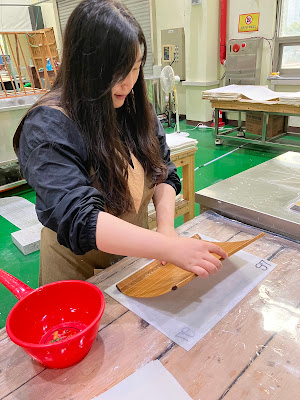Rise & Grind: Time to Make that Paper
We had the opportunity to learn about several South Korean crafts while visiting the city of Jeonju, about a two hour train ride southwest of Seoul. One highlight of our time there was a “Hanji” or papermaking class. If you’ve been reading closely, it was everything the fish cake making experience was not.
Considering we do not speak Korean,
signing up was a bit tricky but we benefited from having several days in
Jeonju. We had visited a public craft
center and museum, and on our way out, Karen stopped by a paper lantern shop.
She was so taken with the pretty lanterns that she struck up a conversation via
Google translate with the artisan who works there. He mentioned that there were
papermaking classes in the building across the street, and we were able to sign
up for one the next morning!
We ended up taking the class on a
Saturday morning and had two other fellow classmates: elementary school-aged
brothers native to Jeonju (chaperoned by their parents). Compared to us, they
were naturals at papermaking and churned out consistent sheets that put ours to
shame. Here are some of the key steps we learned:


2. Once the mulberry pulp is brought to a paper
factory, a small amount is dissolved in water. It gives the water a milky look.

3. Next, a segmented bamboo mat (much like a sushi
making mat), is fixed inside of a wooden frame.

4. Just after stirring the mulberry pulp water, you
dip the bamboo mat into the water and shake the frame back and forth in
multiple directions. As the water strains through the mat, a thin layer of mulberry
pulp is left.
This is the hardest step that requires the most technical skill! If you do
not shake the frame well, your paper will not come out even. In addition, it is
important to dump the remaining water once it is mostly pulp. Otherwise a snot-like blob of pulp will settle on your paper and your sheet will be lumpy and uneven. Finally, we left it to our teacher, but the amount of
mulberry pulp dissolved in the water will determine the thickness of your sheet
of paper. We ran into an issue where our original sheets were too thin and had to
dissolve more pulp into the water.

5. The wet paper is flipped off of the bamboo mat
and left to dry. Normally it takes a full day for the paper to dry, but the
facility we were at had a paper suction device to quickly remove excess water.
Our sheets were also then left to dry for an additional hour on a heated steel
plate.
We walked away from the experience with a newfound appreciation for paper and six precious pieces of our very own Hanji. Now we have to figure out an occasion special enough to use them for…











Comments
Post a Comment